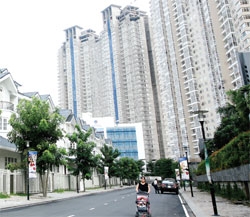Clear property plan needed
 That was the message from the deputy minister of Construction (MoC) Nguyen Tran Nam to an international conference in Hanoi recently.
That was the message from the deputy minister of Construction (MoC) Nguyen Tran Nam to an international conference in Hanoi recently.
Nam said that Vietnam should learn from Singapore, where people have access to apartments, but the country still has vast area for garden.
Nam said the MoC was planning to require residential developers to earmark at least 80 per cent of their project sites for apartments.
The requirement must be met before developers were allowed to build villas and townhouses, Nam said. The policy aims to increase the country’s supply of homes to meet growing demand.
Nam also announced that the government had approved the launch of a national housing fund that would provide low-income earners with accommodation.
The fund works like a usual pension fund, allowing voluntary contributors to withdraw their money with interest of between 3 to 5 per cent a year at their retirement.
“We need this [fund], because with current salary levels, employees’ wish to have accommodation is unreachable,” said Nam.
The main purpose of the fund is to provide home loans to its contributors. Developers of low-cost housing projects are also eligible to borrow from the fund to increase the accommodation stock.
According to the MoC, so far there are around nine million employees on official payroll records and a small contribution of 1 per cent of their monthly income would amount to a fund large enough to finance more housing projects.
Although the Housing Law has since 2006 requested to increase the proportion of apartment buildings in urban area, urban housing structure is still not reasonable.
The MoC stated that the apartment building only accounts for 4 per cent of the total urban housing in the country.
Hanoi has the highest apartment building rate, but only reaches 16.64 per cent while other urban areas have lower apartment building rates.
For the segment of apartment building market, enterprises also pay more attention to the development of large, luxury apartments, and are not interested in the development of small and medium-sized apartments whose selling prices are suitable for the majority of low- and middle-income people.
Vietnam’s apartment sector has seen much fluctuation recently. The medium-quality apartment building price (prices ranging from VND20 million to VND30 million per square metre) and high-end apartments (price ranging of more than VND30 million per square metre) have strongly decreased recently because of the massive supply of high-end apartments.
In Hanoi, within one year from 2009 to early 2010, apartment price increased by 40 per cent. In 2010 the apartment price remained high. In June, 2011 the apartment price has decreased compared to that late 2010, but still lower than that in January 2010.
In Ho Chi Minh City after the slight price increase in mid-2009, the housing market in 2010 and early 2011 continued to look quiet. By 2011 house prices fell by about 5 per cent compared with that at the beginning of the year but the trading is still very quiet.
To 2020, Vietnam needs to increase its housing storage to 2.5 billion square metres from the current of 1.4 billion square metres.
What the stars mean:
★ Poor ★ ★ Promising ★★★ Good ★★★★ Very good ★★★★★ Exceptional
Related Contents
Latest News
More News
- Unlocking urban potential of smart cities (December 18, 2025 | 16:50)
- Green finance offers 'passport' for Vietnamese construction, building materials firms (December 15, 2025 | 08:00)
- Gamuda Land commit long-term investment (December 12, 2025 | 11:49)
- HITC ties up with Evolution to develop AI and hyperscale data centres in Vietnam (December 11, 2025 | 12:09)
- Real estate deals boom via high-profile names (December 08, 2025 | 11:32)
- Industrial segment shaped by M&As (December 08, 2025 | 08:00)
- The Privé sets the benchmark for luxury real estate (December 05, 2025 | 08:28)
- TD CASA and the rise of bespoke interior design in luxury living spaces (December 03, 2025 | 14:14)
- Lee Soo-man's Blooming Sky to build Gia Lai culture, sport, and entertainment complex (December 02, 2025 | 16:41)
- Sustainability in DNA of Keppel Vietnam's future urban development strategy (November 28, 2025 | 10:53)

 Tag:
Tag:




















 Mobile Version
Mobile Version